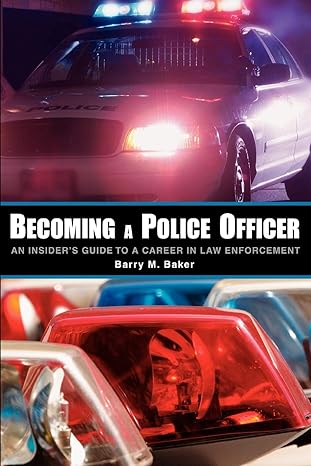
When you’re chasing a vehicle, you’ll have to avoid crashing into vehicles or running over people. That in itself is a goal that’s far from certain, and you’ll have absolutely no control over the fool you’re chasing.
~ Barry M. Baker Tweet

Detective Lieutenant Barry M. Baker (ret.) is a 32 year veteran of the Baltimore Police Department.
A police vehicle pursuit is one of the most dangerous activities in which a police officer can engage since speed is an unpredictable factor. Speed does kill, but speed also enhances the potentially disastrous effects from other factors. Alcohol, drugs, depression and desperation are frequently associated with those who flee from police. Some will be criminals while others will be just stupid.
You’ll need to always think about circumstances that could involve you in a police vehicle pursuit. Your police department will help you by having a written directive governing when and how pursuits should be conducted. When you read your department’s directive, you’ll notice that the terms allowing pursuits are pretty restrictive. For example, nearly every department restricts your speed to only 10 mph above the posted speed limit.
Pursuit Procedures
Suppose your sitting along a street in a built up area where the posted speed limit is 25 mph. A car speeds past you travelling at 60 mph. Simple math tells you that if the car maintains that speed, you won’t catch the violator at 35 mph. A police department directive for a police vehicle pursuit is restrictive, because you’re department does not want you to pursue vehicles.
You might ask this question. “If chasing vehicles is so dangerous, why don’t police departments simply ban pursuits?” The answer is simple. They would if they could, but there will always be circumstances where the fleeing suspect is more dangerous than the pursuit. One example would be a suspect who goes on a killing spree by running down pedestrians at every opportunity.
On November 21, 2021, in Waukesha, WI, a suspect drove his SUV into a Christmas parade killing six people and injuring sixty-two others. The suspect was not being pursued by police. Had a police car been pursuing the suspect when he conducted his attack, there would have been many critics blaming police for initiating the disaster. Some media reports at the time stated the suspect was fleeing from an earlier crime he’d committed. The obvious implication was that the suspect was fleeing from police; even though, there was no police vehicle pursuit.
So Many Variables in a Police Vehicle Pursuit
The Waukesha massacre was well documented on video. One video shows the suspect’s vehicle crashing through wooden street barriers before encountering a high school marching band. A second video shows the suspect vehicle come near to a complete stop behind the band. The vehicle turns slightly, and it lines up directly behind the first row of the marching band. The suspect then accelerates the vehicle, and he begins his act of mass murder.
Would a police vehicle pursuit of the Waukesha killer made a difference? The answer to that question is, “Who knows.” You can speculate using dozens of “what ifs,” but it’s a meaningless exercise. That’s the biggest problem with a police vehicle pursuit. There are so many variables over which you have no control, and that includes your own actions. When you’re chasing a vehicle, you’ll have to avoid crashing into vehicles or running over people. That in itself is a goal that’s far from certain, and you’ll have absolutely no control over the fool you’re chasing.
My First Police Vehicle Pursuit
It was not a high speed pursuit. In fact, it was a very low speed pursuit. As I would come to learn, the operator was a 15 year old girl with a second teenage girl in the passenger seat.
The pursuit began after I observed the vehicle fail to come to a complete stop at a stop sign. We were in a residential neighborhood, and it was after midnight so there was very little traffic moving. When I activated my blue light, the fifteen year old unlicensed driver began leading me on a circuitous route through the neighborhood. I didn’t sense any real danger since the operator was moving at a low speed, and she would slow down at intersections. She wasn’t exceeding the speed limit, and except for trying to elude me, she wasn’t driving recklessly.
The pursuit lasted little more than two minutes before things changed. She was heading for a stop sign that intersected with a main thoroughfare. The row house configuration of the neighborhood made it impossible to observe traffic on the thoroughfare; until, you reached the intersection. The young driver suddenly accelerated, and it was obvious she had no intention of even slowing for the stop sign. My stomach turned to knots as I watched that car blow through that stop sign at about 40 mph.
It Ended Well
I was so relieved when she made it through the intersection unscathed. It was at that instant when I decided to immediately end this police vehicle pursuit. Ironically, the driver had evidently made the same decision. I watched with surprise as she pulled to the curb in the next block.
Both girls exited the car, and they stood on either side of the car. I pulled in behind the vehicle as the passenger was screaming at the driver. The driver said to her girlfriend, “I was just trying to get away.” The second girl shouted back at her, “I told you; you were just pissing him off, and he wouldn’t stop chasing us!”
How wrong the second girl was. I wasn’t pissed off, and I certainly was going to stop chasing them. However, I saw no need to share that part with these girls. It was probably better that the driver believed her friend’s opinion, because that belief might prevent her from doing anything similar in the future. The incident had a very profound effect on me. Thereafter, I set my standard for pursuing a vehicle at a very high level.
Here’s one that Ended Tragically
The 15 year old girl I chased through the streets of Baltimore would be a 40 year old woman when another 15 year old girl, Kristie Priano, would die during a police vehicle pursuit in California.
“January 22, 2002—One minute, Kristie Priano was a 15-year-old honor student and community volunteer laughing with her brother in the back of the family minivan on the way to her high school basketball game. The next, she was one of hundreds who die each year across the nation from the violent crashes due to police pursuits.
More than a third are innocent bystanders—just like Kristie.
What went wrong? The mother of a teenage girl called the police, complaining that her daughter was driving the family car without permission. She told the police where they could find her daughter. Within seconds, the chase was on through a residential neighborhood dotted with two-way stop signs (a
violation of the Chico police pursuit policy). The teen and the police ignored the stop signs even though intersecting streets had the right of way. At the intersection of the fifth stop sign, the teen T-boned the family van directly where Kristie was sitting behind her father, who was driving.” ~ Kristie’sLaw.org
Terminating a Police Vehicle Pursuit
There are two primary ways you can terminate a police vehicle pursuit. First, you can cease pursuing the vehicle. Secondly, you can use your police car to make physical contact with the suspect vehicle commonly known as a pit maneuver. The PIT (Precision Intervention Technique) maneuver requires training, and few police departments outside of state police agencies provide the training.
Scott v Harris is a U.S. Supreme Court case that addresses the second option. Of course, things don’t always go as planned.
“The U.S. Supreme Court (8-1 vote) held that a police officer’s attempt to terminate a dangerous high-speed chase that threatens the lives of innocent bystanders does not violate the Fourth Amendment, even when it places the fleeing motorist at risk of serious bodily injury or death.”
Scott, a Sheriff’s Deputy, attempted to apply a PIT maneuver that failed. Instead, the police car’s push bar hit the rear of Harris’s car sending it off the highway and crashing. Harris’s injuries from the crash rendered him quadriplegic.
Harris sued Scott and others on the basis of Fourth Amendment issues alleging Scott conducted an unlawful seizure when he pushed Harris’s car off the road. The Court agreed that Scott’s contact with the vehicle did constitute a seizure. However, after review of police car dash camera video, the Court found that the seizure was lawful. You can read a full summary of the incident and the Court’s findings HERE.
High Speed Pursuit – Speed and Time
How would you determine a high speed police vehicle pursuit? Well, if your department limits your speed to 10 mph above the posted speed limit, you should consider anything above that as high speed. Speed is relative depending upon where you’re located. An interstate highway with a 70 mph posted speed limit, and the urban street at 25 mph are at opposite ends of the scale.
Speed is obviously the critical factor, but the length of time the pursuit lasts only increases the chances of things going sideways. For example, in the urban environment you’ll encounter more motorists; pedestrians; stop signs; red lights, and any number of other unforeseen obstructions to your pursuit.
Inextricably Linked
Your welfare and the welfare of innocent others are inextricably linked. You may be prepared to take responsibility for your own welfare, but your decisions may also affect others in extraordinary ways. If your decisions do affect innocents in negative or catastrophic ways, you will face accountability.
Why are you initiating a police vehicle pursuit? Have you observed a drive-by shooting, or did the vehicle simply roll through a stop sign? Circumstances are always relevant, but circumstances can change. Will your pursuit of the drive-by shooting vehicle reach a point where circumstances make continuation of the pursuit counter-productive?
Others have Responsibilities for Your Police Vehicle Pursuit
Whoever said these are easy decisions? You will have help, because you’re not the only police officer with responsibilities regarding a police vehicle pursuit. You’ll be required to notify communications when you initiate a vehicle pursuit, and your sergeant will be listening. Don’t be surprised when your sergeant tells you to “break it off.” Even if your sergeant remains silent, there will be other higher ranking police officials listening who have a keen awareness of liability issues.
When you’re told to cease a vehicle pursuit by higher authority, you must comply. If you fail to follow an order to cease, you will be all on your own.
Related Content for Police Vehicle Pursuit
Advertisements



